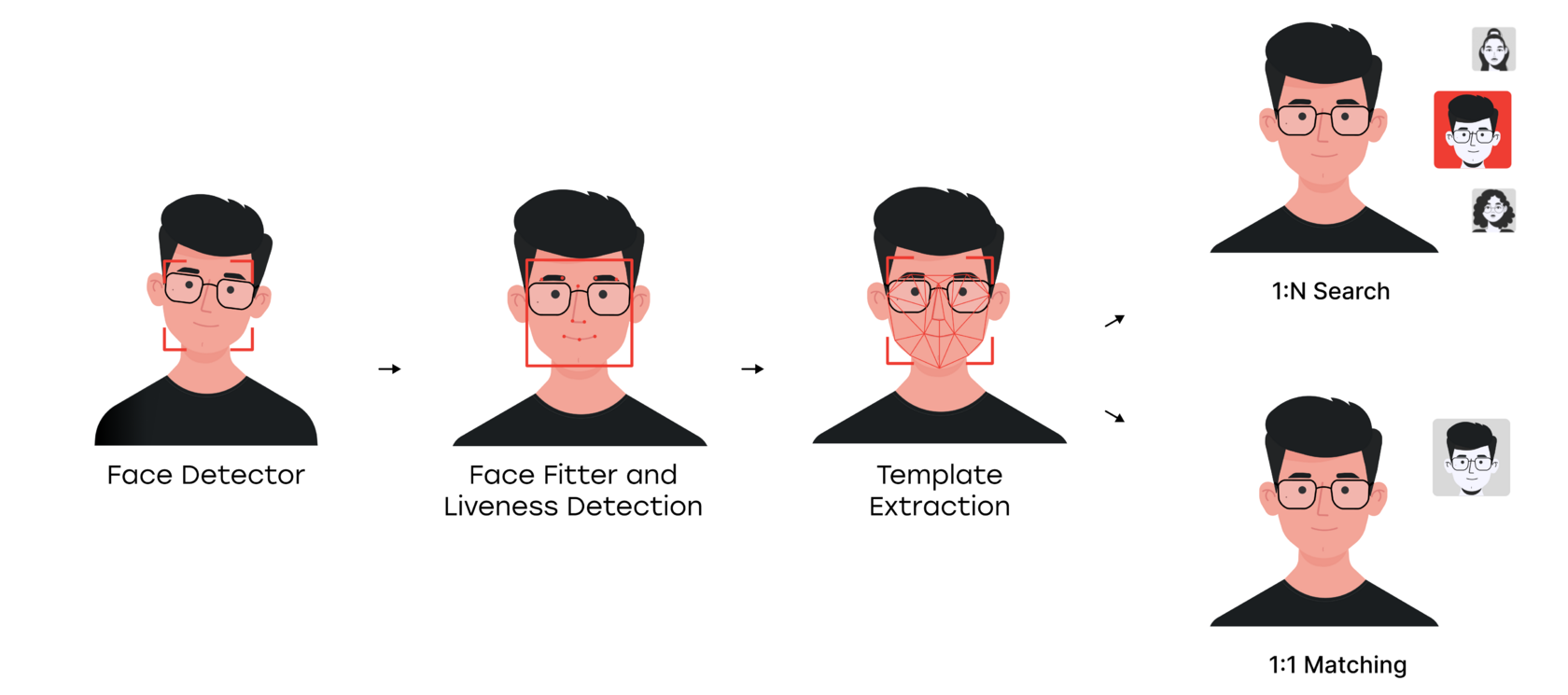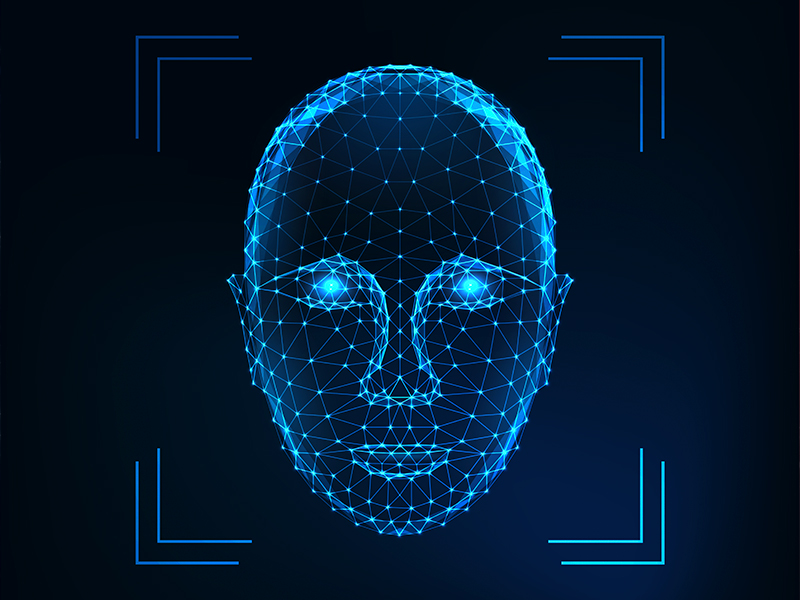Face recognition is a computer vision technology that involves the automatic identification and verification of individuals based on their unique facial features. It is a subfield of biometrics, which focuses on recognizing and analyzing physical and behavioral characteristics for identification purposes.
Facial recognition algorithms analyze facial patterns, such as the arrangement of eyes, nose, mouth, and other facial landmarks, to create a unique facial template or "faceprint" for each individual.
Facial recognition algorithms analyze facial patterns, such as the arrangement of eyes, nose, mouth, and other facial landmarks, to create a unique facial template or "faceprint" for each individual.
How Face Recognition Works
Facial recognition technology typically follows a series of steps to identify and verify individuals based on their unique facial features. Here is a general overview of how facial recognition works:

Face Detection
The process begins with face detection, where an algorithm scans an image or video frame to locate and extract faces. Various techniques, such as Haar cascades, convolutional neural networks (CNNs), or deep learning models, can be used for this purpose.
Face Alignment and Landmark Detection
Once a face is detected, the algorithm identifies key facial landmarks or points, such as the position of the eyes, nose, mouth, and other facial features. This step helps normalize and align faces to a standard position, allowing for accurate comparisons and measurements.
Feature Extraction
Next, the facial recognition algorithm analyzes the facial landmarks and extracts unique features that distinguish one face from another. These features can include the relative distances between facial landmarks, the shape of the eyes, the curvature of the lips, or other spatial relationships.
Face Encoding
The extracted facial features are encoded into a mathematical representation or a feature vector. This encoding typically involves techniques like Principal Component Analysis (PCA), Linear Discriminant Analysis (LDA), or deep learning-based embeddings, such as FaceNet or VGGFace.
Database Comparison
The encoded face features are then compared against a database of pre-existing face templates or faceprints. The database can contain faces of authorized individuals, suspects, or a larger dataset for identification purposes. The comparison can be performed using various algorithms, such as Euclidean distance, cosine similarity, or neural network-based matching.
Matching and Identification
The algorithm determines the similarity or distance between the encoded face features and the faces in the database. If a close match is found, it indicates a potential identification or verification. The algorithm can provide a confidence score or threshold to determine the level of similarity required for a positive match.
Decision and Output
Based on the matching results and the set threshold, the facial recognition system makes a decision, such as confirming the identity of an individual, identifying an unknown person, or rejecting a mismatch. The system may provide additional information, such as the person's identity or relevant metadata, depending on the application.
Key Benefits
Facial recognition technology offers several benefits across various industries and applications. Here are some key advantages:
Stronger Security
Facial recognition provides a high level of security and accuracy in identifying individuals. It can be used for access control systems, secure authentication, and surveillance purposes. By verifying the unique facial features of individuals, it helps prevent unauthorized access and fraud.
Quick Identification
Facial recognition technology enables quick and automated identification processes. It eliminates the need for manual verification, reducing waiting times and improving operational efficiency in scenarios like airport security, border control, or event check-ins.
Better UX
Facial recognition offers a convenient user experience. It can be used for biometric authentication on mobile devices, eliminating the need for passwords or PINs. Users can unlock their devices or access applications simply by presenting their face, making it more user-friendly.
Use Cases
Facial recognition systems have a wide range of use cases across various industries and sectors. Here are some notable examples:
- Access Control: Facial recognition is commonly used for access control systems, allowing authorized individuals to enter secure areas without the need for physical keys or access cards. It is used in industries such as airports, government facilities, corporate offices, and residential complexes to enhance security measures.
- Biometric Authentication: Facial recognition is employed for user authentication on various devices, including smartphones, tablets, and laptops. By scanning and verifying a person's face, it enables secure and convenient unlocking of devices, making passwords or PINs unnecessary.
- Law Enforcement and Surveillance: Facial recognition plays a crucial role in law enforcement and surveillance applications. It can aid in identifying suspects, locating missing persons, and monitoring public spaces for potential security threats. Law enforcement agencies can analyze surveillance footage and compare it against a database of known individuals to assist in investigations.
- Identity Verification and KYC: Facial recognition technology is utilized in identity verification processes for various purposes, such as opening bank accounts, onboarding new customers for financial services, and age verification for online transactions or access to age-restricted content.
- Retail and Marketing: Retailers and marketers employ facial recognition to analyze customer demographics, behaviors, and emotions. This data helps personalize the shopping experience, improve targeted advertising campaigns, and track customer engagement within stores.
- Attendance Tracking and Workforce Management: Facial recognition systems are used for automated time and attendance tracking in workplaces. Employees can clock in and out by facing a camera, reducing errors, and simplifying the payroll process. It also helps prevent time theft and provides insights into employee attendance patterns.
- Personalized Services and Customer Experience: Facial recognition technology enables personalized services across industries. It can be used in hospitality to recognize guests and offer tailored experiences, in healthcare for patient identification and record management, and in entertainment venues to enhance visitor experiences.
- Smart / Safe City Applications: Facial recognition is utilized in smart city initiatives for public safety, traffic management, and crowd control. It can help identify individuals of interest in real-time, monitor public spaces, and optimize traffic flow in congested areas.
How accurate is facial recognition?
The accuracy of facial recognition technology can vary depending on several factors, including the quality of the images or video frames, the algorithms and techniques used, and the specific application or use case. Here are some key points regarding the accuracy of facial recognition:
Quality of Images
The quality and clarity of the images or video frames used for facial recognition greatly impact the accuracy of the system. High-resolution, well-lit, and properly aligned images generally yield better results than low-resolution, blurry, or poorly illuminated images.
Variations in Pose and Expression: Facial recognition algorithms can face challenges when dealing with variations in pose (e.g., different angles or orientations of the face) and facial expressions (e.g., smiling, frowning, or wearing glasses). Advanced algorithms and techniques, including deep learning models, have significantly improved the accuracy in handling these variations.
Enrollment Process
The accuracy of facial recognition can also depend on the quality and diversity of the images used during the enrollment process. A more comprehensive and representative set of images used for creating the initial face template or faceprint can enhance the system's ability to accurately match and identify individuals.
Algorithmic Advances: The accuracy of facial recognition has significantly improved in recent years due to advancements in computer vision techniques, particularly with the rise of deep learning models. Deep learning-based approaches, such as convolutional neural networks (CNNs) and face embedding networks, have demonstrated higher accuracy rates in face recognition tasks.
False Positives and False Negatives
Facial recognition systems can sometimes produce false positives (incorrectly identifying a person) or false negatives (failing to identify a person correctly). The balance between minimizing false positives and false negatives can be adjusted by setting appropriate thresholds or confidence levels based on the specific requirements and use case.
Application-Specific Factors
The accuracy of facial recognition can also be influenced by the specific application or use case. For example, facial recognition for access control in controlled environments (e.g., employee access to a secure building) tends to have higher accuracy compared to facial recognition in uncontrolled and challenging environments (e.g., public spaces with varying lighting conditions and large crowds).
Is facial recognition safe?
Facial recognition systems employ distinctive mathematical patterns to store biometric data, making them one of the most secure and efficient means of identification within the realm of biometric technology. To mitigate the potential for unauthorized access, facial data can be anonymized and safeguarded to maintain privacy. By incorporating liveness detection technology, these systems can differentiate between actual users and facial images, thereby preventing the system from being deceived by a photograph of a living individual.
What is a confidence score in facial recognition?
In face detection and comparison systems, confidence scores, also referred to as similarity scores, play a crucial role. They offer valuable insights into the degree of similarity between two images. A higher confidence score indicates a greater likelihood that the two images correspond to the same individual. Thus, confidence scores utilize AI to determine the presence of a face in an image or establish a match with another face in a separate image.
Threshold for confidence scores
Each prediction made by the facial recognition system using AI is associated with a threshold score level that can be adjusted. Typically, automated matches are based on a high percentage, such as a confidence score above 99%. Lower confidence scores may be utilized to explore the closest potential matches, which are then further assessed by a human investigator.
What are other types of biometric identification technology?
Biometric identification involves the process of recognizing individuals based on distinct and identifiable traits. In addition to facial recognition, there are various other types of biometric identification methods:
- Fingerprint verification: Software for fingerprint recognition verifies an individual's identity by comparing their fingerprint against one or more stored fingerprints in a database.
- DNA matching: DNA matching identifies individuals by analyzing segments of their DNA. This technology sequences the DNA in a laboratory and compares it with samples stored in a database.
- Eye recognition: Eye recognition analyzes features in the iris or patterns of veins in the retina to determine a match and identify an individual.
- Hand geometry recognition: Individuals can be uniquely identified through the geometric features of their hands, such as finger length and hand width. A camera captures a silhouette image of the hand, which is then compared against a database.
- Voice recognition: Voice recognition systems extract distinctive characteristics from an individual's speech to differentiate it from others. It creates a voiceprint, similar to a fingerprint or faceprint, which is then matched against samples in a database.
- Signature recognition: Technology can be used to analyze handwriting style or compare two scanned signatures using advanced algorithms. This allows for identification based on unique signature traits.
























